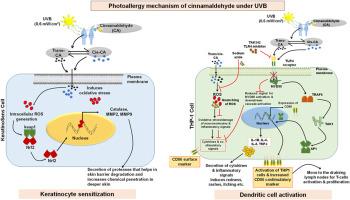环境紫外线照射下肉桂醛的过敏潜力及皮肤过敏的分子机制
IF 8.1
2区 环境科学与生态学
Q1 ENVIRONMENTAL SCIENCES
引用次数: 0
摘要
香料是化妆品中的一种主要成分,经常会引发皮肤过敏,导致皮疹、瘙痒、干燥、皮肤皲裂或脱屑。肉桂醛(CA)提取自肉桂树的树皮,用作香料,是一种中度皮肤过敏物质。肉桂醛具有很强的紫外线吸收能力,其过敏潜力和紫外线照射下皮肤过敏的分子机制在很大程度上仍未得到研究。为了研究 CA 在环境紫外线辐射下诱导皮肤过敏的过敏潜力和分子机制,我们采用了多种可供选择的硅学、化学和体外工具。环境紫外线照射 1 小时后,CA 会从反式异构为顺式异构。此外,DPRA 检测和模拟对接研究表明,顺式 CA 的过敏潜能得到了增强。此外,我们的研究还评估了 KeratinoSens 细胞中的细胞内 ROS 水平和 Nrf2、过氧化氢酶、MMP-2 和 9 的表达,结果表明在有 CA 存在的情况下,UVB 暴露会显著上调细胞内 ROS 水平和 Nrf2、过氧化氢酶、MMP-2 和 9 的表达。此外,我们的研究结果表明,CA 可通过激活细胞内 ROS、吞噬作用和 TLR4 通路基因来激活 THP-1 细胞共刺激表面标志物(CD86)。我们的研究揭示的这些机制对于控制因使用香料和同时暴露于环境紫外线/阳光而引发的过敏性皮肤病至关重要。本文章由计算机程序翻译,如有差异,请以英文原文为准。

Allergic potential & molecular mechanism of skin sensitization of cinnamaldehyde under environmental UVB exposure
Fragrance, a key ingredient in cosmetics, often triggers skin allergy causes rashes, itching, dryness, and cracked or scaly skin. Cinnamaldehyde (CA), derived from the bark of the cinnamon tree, used as a fragrance and is a moderate skin sensitizer. CA exhibits strong UVB absorption, its allergic potential and the molecular mechanisms underlying skin sensitization under UVB exposure remain largely unexplored. To investigate the allergic potential and molecular mechanisms of CA-induced skin sensitization under ambient UVB radiation, we employed various alternative in-silico, in-chemico and in-vitro tools. CA under ambient UVB isomerizes from trans to cis CA after 1hr of exposure. Furthermore, DPRA assay and docking with simulation studies demonstrated the enhanced allergic potential of cis-CA. Additionally, our study evaluated intracellular ROS levels and the expression of Nrf2, Catalase, and MMP-2, and 9 in KeratinoSens cells, showing significant upregulation under UVB exposure in the presence of CA. Moreover, our findings indicate that CA activates THP-1 cells co-stimulatory surface marker (CD86) via the activation of intracellular ROS, phagocytosis, and genes of the TLR4 pathway. These insights into the mechanisms uncovered by our study are crucial for managing triggers of allergic skin diseases caused by fragrance use and concurrent exposure to environmental UVB/sunlight.
求助全文
通过发布文献求助,成功后即可免费获取论文全文。
去求助
来源期刊

Chemosphere
环境科学-环境科学
CiteScore
15.80
自引率
8.00%
发文量
4975
审稿时长
3.4 months
期刊介绍:
Chemosphere, being an international multidisciplinary journal, is dedicated to publishing original communications and review articles on chemicals in the environment. The scope covers a wide range of topics, including the identification, quantification, behavior, fate, toxicology, treatment, and remediation of chemicals in the bio-, hydro-, litho-, and atmosphere, ensuring the broad dissemination of research in this field.
 求助内容:
求助内容: 应助结果提醒方式:
应助结果提醒方式:


